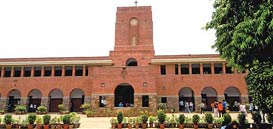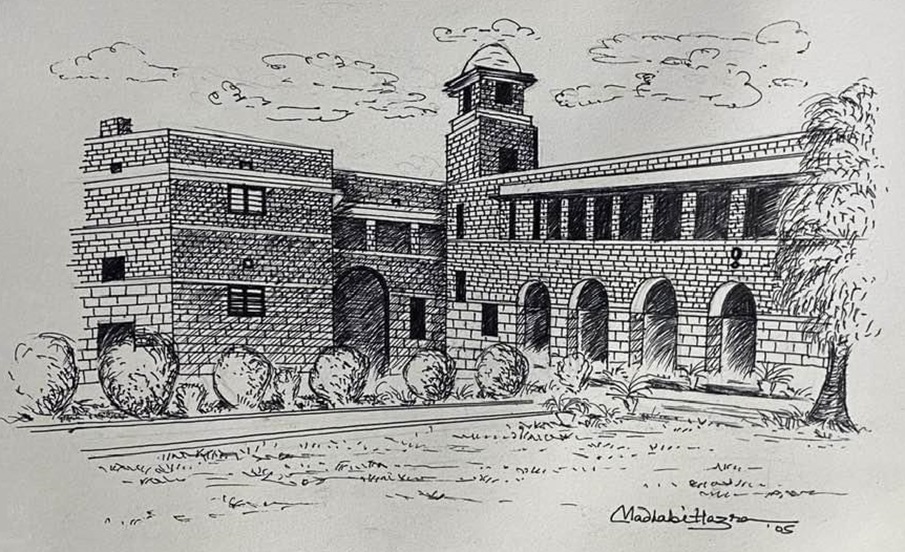St. Stephen's College, Delhi
This is a collection of articles archived for the excellence of their content. |
Contents |
Admission criteria
Supreme Court judgement 2022
Oct 19, 2022: The Times of India
New Delhi: The Supreme Court refused to stay the Delhi High Court order asking St. Stephen's College here to follow the admission policy prescribed by the Delhi University. A bench of Justices Ajay Rastogi and C T Ravikumar said it was not inclined to interfere with the HC judgement.
"We find no reason to stay the judgement, therefore the application for interim relief is dismissed," the bench said.
The top court was hearing a plea of St Stephen's College against a Delhi High Court order which asked it to follow the admission policy of the Delhi University.
The Delhi High Court had on September 12 asked the Christian minority institution to follow the admission policy formulated by the Delhi University according to which 100 per cent weightage has to be given to the Common University Entrance Test (CUET)-2022 score while granting admission to non-minority students in its undergraduate courses.
The high court had said the college cannot conduct interviews for non-minority category students and that the admission should be as per the CUET score alone.
The high court had also said the rights accorded to a minority institution under the Constitution cannot be extended to non-minorities. It had said the college has the authority to conduct interviews, in addition to the CUET score, for admitting Christian students but it cannot force non-minority candidates to additionally appear for an interview.
The HC bench, while asking the St Stephen's College to withdraw its prospectus giving 15 per cent weightage to interview for admission against unreserved seats, besides taking into consideration the CUET score of a candidate, had, however, ruled the DU "cannot insist upon a single merit list for admission of candidates belonging to the Christian community regardless of denomination, etc".
The high court's order had come on petitions filed by a law student and the college with respect to the legality of the procedure for admission of students against unreserved non-minority seats for UG courses.
Agitations by students
St Stephen’s is an apolitical college. Elections to the Students’ Union [till 1974, when Shashi Tharoor, as the President of the College Union, gave it this name, it was known as the Students’ Union Society] are contested on non-party, apolitical lines. Stephanians have stayed away from student politics and agitations.
However, there have been exceptions.
1972
The Students’ Union Society, led by Nripen Dutta Baruah, went on a prolonged agitation against a sudden and steep increase in residential fees, for messing and accommodation, which were already the highest in India for a non-professional, mainly- undergraduate college.
They succeeded in moderating the increase in the fees.
1990
A teacher, Ashley NP, said that [during the] Mandal agitations students of the college went on strike and boycotted classes.
2020
Shradha Chettri , January 9, 2020: The Times of India
A first in 30 yrs: St Stephen’s students boycott classes, read Preamble in rain
Shradha.Chettri@timesgroup.com
As there was a call for a nationwide strike on [Jan 8], it was the students of St Stephen’s College coming out to protest, that took everyone by surprise. Many applauded the students of the college for standing in solidarity with their counterparts from Jamia Millia Islamia and Jawaharlal Nehru University (JNU).
Students of the DU college braved rain to protest against the Citizenship Amendment Act and National Register for Citizens.
Leaving classrooms empty, they walked towards the lawns to join the protest around 10 am.
Raman Mohora, president of the student’s union, said that almost all the students of the college participated in the protest. “It was a collective decision that the students of the college took. The movement across the country is being led and inspired by women. Even in Stephen’s too, that happened,” said Mohora.
Shouting slogans of azadi, reciting poems and carrying placards, students marched around the college. They later marched along with other Delhi University colleges. Students stuck posters on the doors of students’ common room, which read, “hum kaagaz nahin dekhaenge” and “Chankrasheekar Azad ko azad karo”.
The students even read the Preamble as teachers joined them. Mathematics teacher Nandita Narain addressed the students in the college and they sang songs by Faiz Ahmed Faiz — “Laazim hai ki hum bhi dekhenge”. Among several placards, a few read: “We are here for rights and not riots” and “The darkest places in hell are reserved for those who maintain their neutrality in times of moral crisis”.
“It was heartwarming to see almost entire college coming out together to protest,” said a student, who did not want to be named.
Cut-offs
Cutoffs, 2015-17
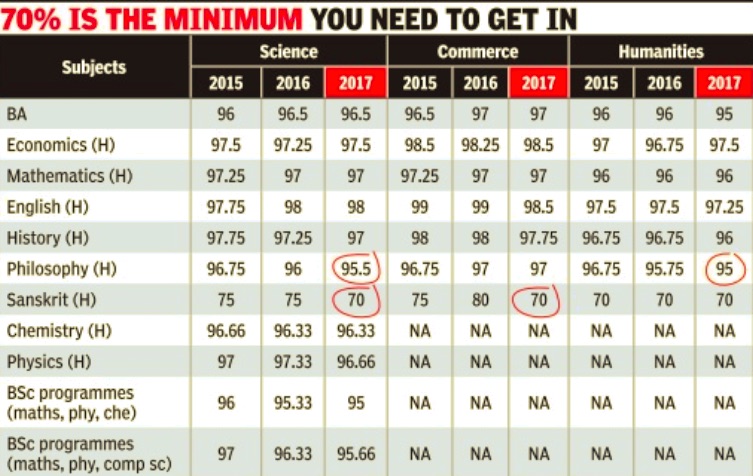
St Stephen's College wants to interview more students for a better pool of choice this year for its undergraduate courses. This also explains the dip in cutoff percentages, especially for humanities, in one of the most prestigious and competitive institutions of Delhi University.
The cutoff at St Stephen's is decided on percentages scored by the top lot of students in aparticular course. With just a few top-scoring candidates competing for a single seat, the cutoff percentage is bound to go up.
However, this year, the teachers decided to increase the ratio of students per seat, so that they have more students to interview and select from.
The cutoff for humanities candidates has dipped by around 0.5% this year. The first cutoff for the popular BA (programme) course has gone down to 95% from 96% last year. Similarly , the cutoff for English (honours) has come down to 97.25% from 97.5% last year. The cutoff percentages for all subjects for humanities students have dipped, except Sanskrit that has stayed static at 70%.
For candidates from scien ce background, getting into Stephen's has been made easier. Percentages for chemistry (honours), physics (honours) and the two BSc (programme) courses have also fallen. However, mathematics (honours) has remained at 97%.
AD Mathur, tutor of admissions at St Stephen's, said students who come in subsequent lists get picked because the seats need to be filled. “By the time the last interview takes place, most of our students have taken admission in other colleges. So this time we decided to bring more students in the first few lists and take real interviews instead of just fil ling seats,“ he said.
This year, the ratio has been changed to four students per seat under humanities and six students for sciences. This means even those who ranked below the top scorers will be considered for an aptitude test and interview.
Teachers said that the in terview process has also been streamlined. The interview has a 10% weightage, while the aptitude test has 5%. Nandita Narain, a maths teacher, said the candidate's marks of the aptitude test will be sent to the interview panel. The panel will then ask candidates questions on the aptitude test, among other topics. “This has been done to make the interview less arbitrary. Though some teachers were not in favour of it, it was decided to be adopted nevertheless,“ she added.
2018-19
June 25, 2019: The Times of India
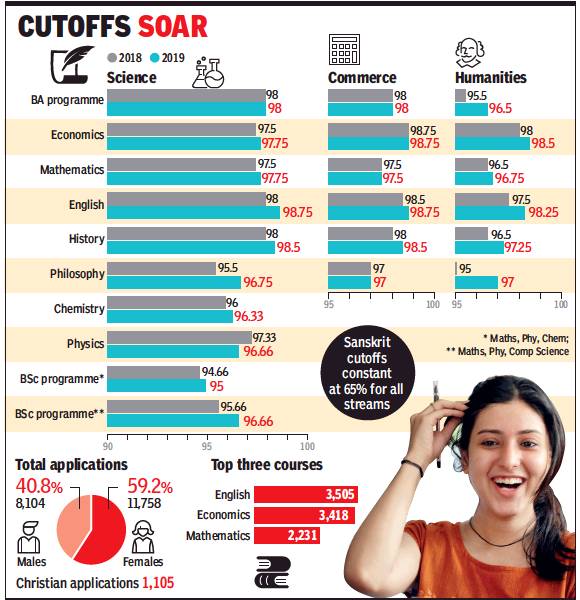
From: June 25, 2019: The Times of India
You need at least 95% to get into St Stephen’s
New Delhi:
A score of 95% and above is the only way to secure a seat at St Stephen’s College this year if you are a general-category candidate. As the Delhi University (DU) college released its cutoffs, the required percentage for eight out of its 10 undergraduate courses have gone up from 0.25 to 2% points, with the highest cutoff being 98.75%. For English (Hons), commerce and science students will require 98.75%, while in economics (H), the cutoff will also be 98.75% for commerce students, just like the last two years.
However, it is philosophy (H), which has seen the highest jump of 2% points. For humanities students, the cutoff is 97% instead of 95% last year. This is followed by BSc programme with a combination of mathematics, physics and computer science at 96.66%, a jump of 1% point. Even for the combination with chemistry, the cutoff has increased to 95% from 94.66%.
The only subject, which has seen a drop, is physics (Hons) — 96.66% from 97.33%; while for Sanskrit (H), the cutoff remains the same at 65%.
The religious minority college releases separate cutoffs and 50% of its seats is reserved for Christian candidates. However, this year, the college has released cutoffs for just general category and Church of North India candidates. Earlier, the cutoffs used to be declared for schedule caste, schedule tribe and other Christian candidates as well. The increase in the cutoffs also hints at a likely trend in the other 61 DU colleges, where the first list will be declared on June 28. “In the first few lists, one can expect the cutoff to be on the higher side. We also have no option considering a large number of students scoring such high marks,” said the principal of a North Campus college.
With the highest number of applications, the cutoff for English (H) has increased by 0.25 to 0.75% points. For humanities candidates, the cutoff has increased from 97.5% to 98.25%; for science and commerce, from 98% to 98.75%, and from 98.5% to 98.75%, respectively.
Economics (Hons), the second-most popular course at Delhi University, has seen a 0.5% point increase. Instead of last year’s 98%, humanities students will need 98.5% and science students 97.75% against last year’s 97.5%. Incommerce, the number remains the same at 98.75%. At St Stephen’s, the admission is held on the basis of an aptitude test and an interview. It gives 5% weightage to the test, 10% to the interview and the rest to the board marks. This year, all courses — with 410 seats — will have aptitude tests.
In mathematics, the cutoff has increased by 0.25% points, with the highest cutoff is for science students at 97.75%. Chemistry (H) has seen a 0.33% point increase to 96.33%.
For humanities students, the cutoff in BA Programme has increased from 95.5% to 96.5%. In History (Hons), the candidates will need 0.5 to 0.75% points more.
For Christian candidates, the cutoffs have fallen up to 5%.
History
1975: co-education restored
Supriya Guha, May 5, 2022: The Times of India
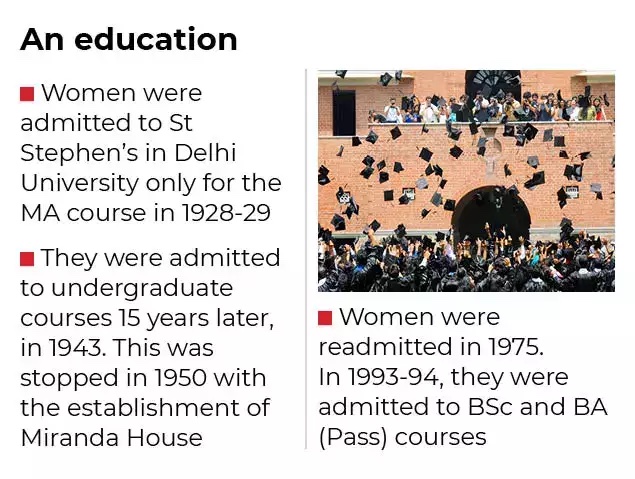
From: Supriya Guha, May 5, 2022: The Times of India
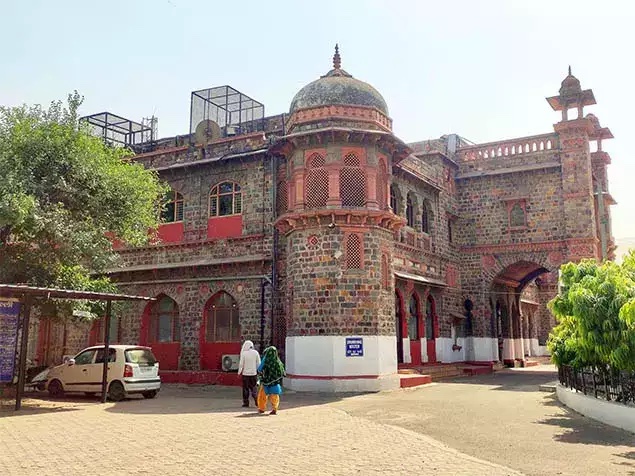
From: Supriya Guha, May 5, 2022: The Times of India
In 1975, the prestigious college became co-educational after a hiatus of 25 years. As the Delhi University marks its centenary year, a former student looks back at those times and reflects on what it was like being young and discovering new worlds
It was a lucky happenstance. The United Nations had declared 1975 the ‘International Year of Women’ and the Union ministry of education decided that all colleges in the University of Delhi would become co-educational, or rather, all the men’s colleges would cease to be exclusively so — although women’s colleges remained single-sex institutions. Thus, the giant waves created by the women’s movements around the world helped to create the tiny ripple that affected our lives.
Once we learned that our marks were good enough, we were delighted that we could study at St Stephen’s College, where so many of us had elder brothers.
So, there we were. All 47 of us. Most of us from girls’ schools, scarcely acquainted with members of the opposite sex, and quite willing to be convinced that the young men were cleverer, more worldly and more knowledgeable than we were.
Perfect targets, in other words, for “mansplaining” — though the word hadn’t been invented then — on a mass scale. It was true that most schools in Delhi had been single-sex, with a couple of exceptions, but the pool from where the students were drawn was small. There were no hostels for girls and so all of us were from Delhi, unlike the young men who came from different parts of the country.
The young men in college at the time decided to be staunchly against the entry of women, who they said would “poison the atmosphere”, essentially, the easy male bonding which had been characteristic of the idyllic all-male world.
It was quite fashionable to talk about how college had been positively ruined — as an unofficial dress code was allegedly prescribed and lecturers became more circumspect in their jokes and the anecdotes narrated in the classroom.
One senior student declared he was going to write an article in the college rag, entitled, “The First Blast of the Trumpet of the Monstrous Regiment of Women”. It was only when we got a little further in our reading of British history, then taught in great detail, that we recognised the title of a polemic by that celebrated Scots Reformer and misogynist, John Knox.
The other moan was about the famous college anthems, the “Farmer’s Song” and the “Blacksmith’s Song”, which could no longer be sung with full-throated uninhibitedness because of our presence. We wondered what those famous songs were actually about, until one of us stumbled across a book of English rugby songs in a bookshop.
It was a complete letdown to read the schoolboy smuttiness of the words, but also a wonder to think of the great pride at passing them off as highly distinctive. Indeed, they were but a part of the general atmosphere of laddishness some of the men aspired to.
As feisty young women, I don’t think we were greatly concerned. I remember a guy, famous for his skill at punning, trying hard to impress the prettiest girl in the college with a series of what were called “lobs”. She looked at him with an expression of complete placidity and asked him if he was practising for a career in advertising.
Once past the posturing, which lasted perhaps the first couple of weeks or most of the first term, there emerged the discovery of common interests, new ideas to learn, and we formed some genuine friendships that have lasted many years. There were new kinds of music to hear and learn about, new authors to discover and read, and an exciting new world of quizzes, debates, and drama. Delhi was having a sort of theatrical efflorescence at the time, with many students from college active in amateur plays.
About 10 years later, at a time when there were very many more women students, there was an unpleasant episode involving what was called a “Chick Chart”, rating the women according to their sexual attractiveness. I was pleasantly surprised to learn that there had been a strong adverse reaction to it. “Laughing it off” was no longer the only recourse.
When I look back today, I think, we were spared many hurt feelings and humiliations because there was no social media in 1975. I have no doubt unpleasant and unkind things were said about many from that first batch of women who joined St Stephen’s College, and, indeed, we sometimes got to hear of them. But we were spared complete awareness and that proved a blessing, so that little impeded the excitement of being young and discovering new worlds.
This building in Kashmere Gate housed St Stephen's College from 1891 to 1941, after which the college was moved to its present location. There were a few women students back then but their entry was discontinued in 1949
Quite why there was such general excitement about our entry, I cannot now say. There had been women in St Stephen’s up to 1950, and a hiatus of 25 years seems insignificant, especially in a college nearly 150 years old. The probability is that those two and a half decades were very significant in the crystallisation of the Stephanian ethos, or shall we call it mythos?
These coincided with the years the English-speaking middle class grew in confidence and self-consequence. That world of exclusive male camaraderie, derived from public school values and from desi notions of yaarana , was already dated in 1975.
The writer studied history at St Stephen’s College from 1975 to 1980. She has a PhD on the history of midwifery in colonial Bengal
Reservation of seats for CNI, others
As in 2018
Krittika Sharma, No. of general seats dips at Stephen’s, May 24, 2018: The Times of India
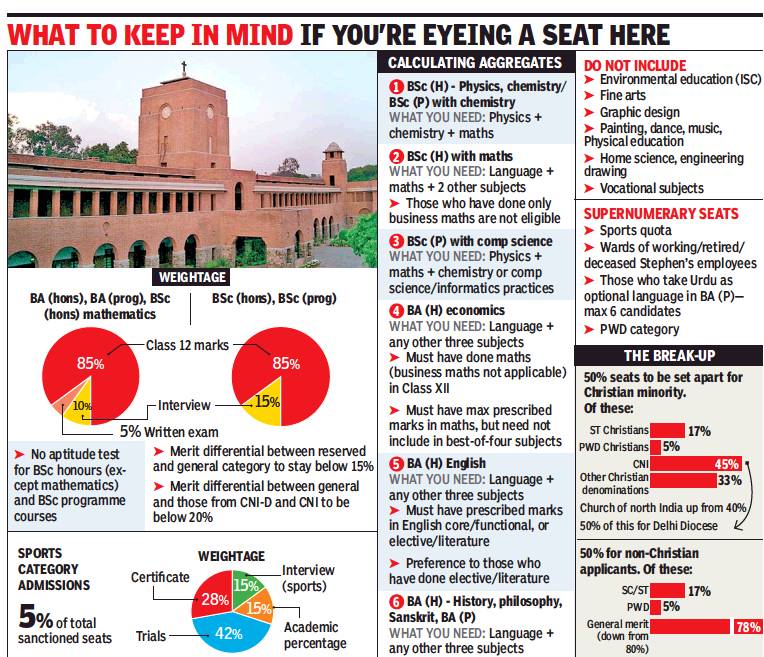
From: Krittika Sharma, No. of general seats dips at Stephen’s, May 24, 2018: The Times of India
Quota Up For Church Of North India Applicants
St Stephen’s College, which started its admissions on May 21, has increased the quota for the applicants from Church of North India (CNI) from 20% to up to 22.5% of the total seats. Non-Christian, general category aspirants, on the other hand, will have 39% of the total seats instead of last year’s 40%.
Being a minority institution, St Stephen’s reserves 50% of its seats for Christian students, including a major chunk for those from CNI. The college’s highest decision-making body is made of CNI members and its chairman is the bishop of Diocese of Delhi.
The cap for CNI applicants has gone up from 40% of the reserved seats for Christian candidates to 45%, with 50% of these seats (11.25 % of the total) being kept for those from CNI-Delhi Diocese, which manages the college, states the 2018-19 prospectus. The principal has also been empowered to fill up vacant seats meant for Christian applicants with any Christian category aspirant.
Of the 50% seats reserved for non-Christians, 78% have been earmarked for the general category, down from 80% last year. The proportion of non-Christian aspirants under the SC/ST category has gone up from 7.5% to 8.5% of the total seats.
The difference in merit cutoffs between general and Christian aspirants have widened with the latter getting up to 20% relaxation.
For supernumery seats, the college will take in three candidates from among the children of the defence personnel who have lost their lives in the line of duty.
The administration has also decided to do away with a written exam for BSc (honours)—except for maths—and BSc (program) courses.
To ensure greater transparency, it has declared the ratio of students versus seat for interviews. For humanities, four applicants — six for Christians — will be called for every seat while for science, six aspirants — eight for Christians — will be interviewed. The interviews are to start with mathematics on June 18 and end with sports on July 6. Verification of all certificates has to be done by July 31.
Traditions
2019: Anga Oath cancelled
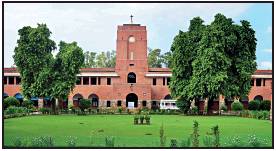
From: Mohammad Ibrar, Stephen’s cancels ‘sexist’ Valentine’s Day ritual, February 14, 2019: The Times of India
Breaking away from a four-decadelong tradition, members of the Allnutt North Gentlemen’s Association (ANGA), St Stephen’s College’s residential facility for boys, has decided to cancel the ‘Anga Oath’ in 2019 on Valentine’s Day after protests from women students. The oath is accused of promoting misogyny, and the hostel residents said they do not support it.
The oath, which states that the Anga hostel dwellers would “promote misogyny”, takes place every year since the 1970s as a mark of resentment against admission of women students in the college.
“We have decided to cancel the event this year as we don’t promote it,” said Srijit Seal, hostel students’ representative and third year chemistry student.
Last year, after massive protests, the oath was altered by the hostellers to be less sexist and misogynist. “This was a mere token gesture from the hostel students after they faced protests,” said a member of the Pinjra Tod collective.
Maitreyi Jha, a second year history student, was part of the agitation against the ‘tradition’, said that it had to go completely, as the oath’s history was not erased.
Unlike Stephen’s, Hindu College hostel students are continuing with their ‘virgin tree puja’ — another ritual that has evoked protests over the years for its misogyny and objectification of women.
This year, after facing protests, the Hindu College students have decided to worship a celebrity couple, instead of a woman celebrity as Damdami Mai. However, several students and Pinjra Tod have decided to conduct a protest at the site and block the event.
YEAR-WISE DEVELOPMENTS
2014
India's no. 2 in Arts
All ranks below indicate the college's position among India's best Arts colleges and were determined by India Today
CITY: New Delhi
Founded on February 1, 1881, St. Stephen's is the oldest college in Delhi. It was first affiliated to Calcutta University, and later to Punjab University. With the establishment of Delhi University in 1922, it became one of its three original constituent colleges.
PARAMETER-WISE RANKING
Reputation: 2
Academic Input: 2
Student Care: 2
Infrastructure: 2
Placement: 2
Perceptual Rank: 2
Factual Rank: 11
2015
India’s no. 1 in Arts
2015: Becomes a ‘Society’
The Times of India, Nov 20 2015
St Stephen's set to turn `society' leaf
The draft constitution of St Stephen's Educational Society signifies massive changes in the future running of Delhi's best-known college. The draft, which became public on Thursday , will be tabled at a special meeting of the St Stephen's College governing body on November 23. For starters, the draft pertains to a St Stephen's Educational Society instead of St Stephen's College, itself a society. This society is a new entity that will have a governing body--which is now the college's supreme council -now slightly expanded with seven members instead of six. The supreme council is composed entirely of Church of North India members.
The supreme council will oversee “institutions“, meaning “educational institutions, schools, colleges, universities, medical colleges, research and learning centres established by the society .“ This suggest plans for expansion and St Stephen's College will be one of the institutions each of which will have its own governing body .
The college's governing body, argues lawyer and alumnus Sunil Mathews, is being “left toothless.“ The draft's proposals reduce the teacher repre sentation in the GB. The present GB has four positions for teachers -two elected, two appointed by rotation. The new one, if this draft is passed, will have just two and by rotation.
“The present GB where this will be placed is improperly constituted. The teachers' election couldn't take place at all but decisions are being taken. It is important to have elected members to serve as checks,“ says Nandita Narain, maths teacher, Delhi University Teachers' Association chief.
The GB will have the power to create “new categories of posts other than purely temporary posts“, a provision Mathews sees as violation of the University Grants Commission's norms. “The council used to appoint only the principal and took some decisions on admissions. Now it has most of the powers the GB enjoyed,“ adds Mathews. This list includes powers to “lay down guidelines governing admissions of students and appointment of teaching faculty, control policy, development and direction of the institution(s), to administer the finances and control the income and expenditure of the institution(s). It will also “have the power to veto, over-rule, supersede, amend, modify , and or suspend any decision taken by the governing body .“ As per the original constitution, “The supreme council shall have control of the religious and moral instruction of students and, in addition, shall appoint the principal after proper advertisement.“
“Clearly , the supreme council was never given a role in administrative matters. Our founding fathers wanted to keep the religious aspect separate from academic and administrative matters,“ said Narain.
The principal's role will change too. “The principal shall have and exercise complete control over the discipline of the institution, the courses taught in the college as well as its day-to-day administration,“ says the draft.
However, the principal's role is being expanded in disciplinary matters, originally the GB's province. The principal will act “as immediate authority in all disciplinary matters pertaining to governing body appointees subject to ratification of such action by the governing body and as final authority in respect of all other employees,“ says the draft.The principal has also the power to decide “which staff members shall reside in the institution's staff quarters“ and also recommend for increments. “This is clearly an attempt to throw some of us out of the campus,“ says Narain.
2016: Drop in number of applicants
The Times of India, June 19, 2016
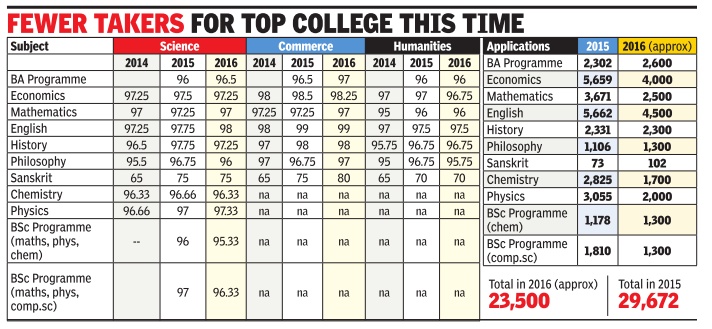
Shreya Roychowdhury
Stephen's applications down by 20%
There has been a major drop in the number of applications for the 410 seats on offer at St Stephen's College this year. Compared with 29,672 applications received last year, as disclosed by the college, there were only aro und 23,500 students who were interested in studying there this year, implying a decline of over 20%. The college authorities “haven't analysed the reasons“ yet, but teachers said the “widespread confusion“ created by the college following an admission schedule different from Delhi Univer sity's might be behind the slide. The applications were last received till midnight of June 17, 2016.
Almost all major disciplines showed a drop in applications. Economics saw a 29% decrease, mathematics 31%, English 20%, chemistry 39%, physics 34%, and BSc Programme (with chemistry) 28%. While the exact figures were not available, the drop in the cut-offs in these subjects reflected the decline in applications. Applications, however, were higher than last year for BA Programme (12%), philosophy (17%), Sanskrit (39%) and BSc Programme (computer science, 28%).
The public information officer of the college, AD Mathur, did not seem perturbed.“The numbers dropping by a few thousand doesn't mean anything because 23,500 is still a huge number considering the very few seats available,“ he said. In contrast, Delhi University , as a whole, received 2,15,525 applications by Saturday evening, and the last date of registration has been extended to June 22.
St Stephen's teachers, however, won't speak on record.They alleged receiving a notice from the college administration forbidding them to discuss admissions with the media. “There was widespread confusion among students,“ explained a senior te acher. “Usually , DU makes it clear on its website that St Stephen's and Jesus and Mary colleges follow a different process, but didn't this time.Nor was the college proactive about publicising the process. Also, earlier our dates were synchronised to those of Delhi University , but this year they weren't. Even today I met a girl who was crying because she thought she had till June 19 to apply .“
Another teacher, who found the disinterest “strange“, said there was talk of the fees having gone up. If true, that could a factor, she said. “But,“ she continued, “we have to see if there's a decline in relation to DU or a decline in the university overall.“
Some teachers felt that the periodic upheavals the college has gone through and the “general disillusionment“ could be why applicants were deterred, though not many agreed.“The college has an aura of unattainability and that alone attracts many . I don't think the controversies impacted the admission procedure,“ said one of them.
